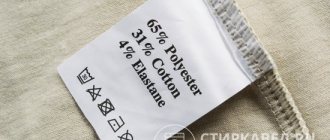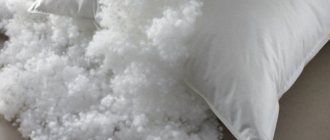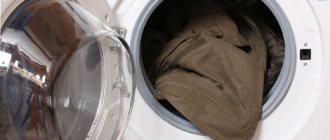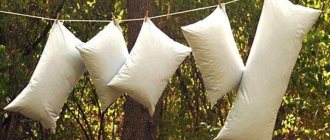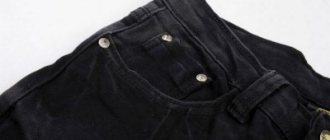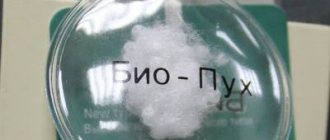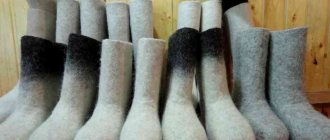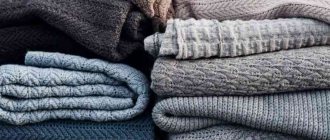Polyester is a modern synthetic material. It is ideal for sewing outerwear. Polyester fabric is very durable, wear-resistant, breathable, does not stretch, does not wrinkle, and dries quickly. Products made from this material are very warm.
At first glance, it seems that washing a polyester jacket is very easy: nothing will be done to such material. In fact, such a product also has its own care rules. If you do not follow them, then after washing you can end up with a jacket that is very different from its original appearance. Let's figure out how to do everything right and avoid trouble.
What to do before washing a polyester jacket
On it you can see useful information about the washing mode (hand or machine), permissible water temperature, fabric composition and whether the product can be ironed;
Study the label carefully.- Remove stains from the down jacket. If this is not done immediately, they will remain after machine washing. We will write about stain removal below;
- Check the pockets for foreign objects , remove the hood and fur trim (they should be washed separately), take out the belt, fasten the down jacket with buttons or a zipper, and turn it inside out.
Removing stains
Quite often, many visitors to dry cleaners ask the specialists of this service a simple question: how to clean a jacket and a shiny polyester jacket collar? There are many ways to effectively and safely clean products made from this synthetic material. In order to remove uncomfortable and unsightly shiny streaks, there are many widely used cleaning options. Let's look at some of the most effective methods.
Dish gel (liquid detergent)
The easiest way to deal with stains is to use a mild stain remover or liquid detergent. They do not contain aggressive chemicals, so the synthetic fabric is not damaged. Apply the product to the stain for 15-30 minutes, then gently rub with a brush and rinse with water.
To remove a small stain, take a clean, non-fading cotton cloth. Apply a little gel to it first, wipe the stain with short movements, without smearing it on the jacket. Then a clean corner of the cloth is lightly moistened with water. If this does not work, the water must be completely squeezed out. And wipe the stain with short movements too. The stain will come off. Let this area dry; in this case, the item does not need to be rinsed. After drying, there will be no trace left of the stain.
The main thing is not to use a lot of gel and water, then the stain will not spread. If you properly and systematically care for a polyester item, it will delight its owner with its excellent appearance for many years!
Using soap
The simplest, and sometimes the most effective way of cleaning is the option in which a piece of ordinary soap can help. Before starting the procedure, you need to be on the safe side and test the effect of the soap on a small piece of fabric, which is usually attached to the wrong side of each product.
It is more advisable to start cleaning with a weak solution, increasing its concentration if necessary. You should not get carried away and try to clean your jacket with a thick, sticky mixture. It will be much more effective to use a weaker solution, performing the entire cleaning procedure many times.
First, prepare: a cotton swab, a piece of clean cotton wool or a small light cloth.
- gently moisten the cloth near the stain, moving from the edges to the center;
- try to avoid highly concentrated chemical stain removers;
- can damage the material of your product and spoil its appearance;
- When cleaning stains, use simple (laundry soap), this is much more expedient and cheaper.
The above method, even if unsuccessful, will not allow the oily stain to spread further.
If the cleaning method did not live up to your hopes, and the result turned out to be disappointing, try a few more popular options for removing greasy stains.
Salt
In addition to using soap, there is an old, proven cleaning method that our grandmothers successfully used in ancient times, when cleaning products were unheard of. Your clothes will be at minimal risk of damage and will look clean and tidy if you use regular table salt. This inexpensive, popular product allows you to clean a grimy polyester jacket collar.
To begin, sprinkle a small amount of salt on the contaminated area, rub thoroughly with your fingers and shake off the product. To achieve a positive result, repeat the entire procedure several times, and the dirty stain will disappear without a trace.
Sodium tetraborate
Another highly cleaning effect is achieved by the method of removing stains on colored and light-colored clothing, in which a 100% borax solution is used. In this processing option we proceed in the following order:
- Apply a small amount of the substance to a clean cotton swab and wipe the contaminated surface of the polyester jacket;
- thoroughly wipe the treated part with citric acid and carefully rinse the product.
If all of the above methods for cleaning deep-seated oil stains fail to completely clean your clothes, you can try a more advanced cleaning procedure. In this case, you should proceed according to the following scheme:
- moisten the area around the remaining drip with warm water;
- In the area of the stain on the inside of the product, place a paper napkin folded several times;
- Apply a thin layer of starch around the entire perimeter of the contaminated area;
- take a piece of not very dense fabric, fold it several times and cover the stain with it;
Carefully iron the surface to be treated with a hot iron.
If the result is unsatisfactory, repeat the procedure several times.
The main thing to remember is that it is much easier to remove a fresh stain and start treating it as early as possible.
Under no circumstances should greasy polyester be boiled, otherwise you may end up with an irreparably damaged product.
If the contamination is obtained on some flat area - the chest or back, you can try the so-called waterless method.
Starch
You will need starch, a thick napkin, a piece of fairly thick fabric such as cotton and a hot iron:
- The area around the stain should be treated with a little water so that when heated the oil does not spread over the clean surface;
- On the inside, under the stain, place a napkin folded several times;
- Using a teaspoon, starch is carefully distributed evenly over the stain;
- A fabric folded in half is placed on top of the starch;
- Use a hot iron to gently but thoroughly iron the top.
If you see how oil or fat appears through the starch onto the fabric that was placed on top, then the desired effect has been achieved. All that remains is to check whether the contamination has disappeared 100 percent. We remove the napkin and cloth, and if anything remains, the procedure will have to be repeated.
The area of contamination is moistened and a large layer of salt is poured on top. After half an hour, rinse the item in soapy water.
Find out whether a polyester jacket can be washed in an automatic washing machine, and what care conditions are determined by the image on the product tag.
The number in the picture in the bowl of water indicates the recommended water temperature for washing. If the adjacent triangle is crossed out, bleaching is prohibited. A circle in a square implies spinning in a centrifuge. If it is crossed out, this cannot be done.
In the picture of the iron, from 1 to 3 dots show the temperature when ironing 1 dot, the lowest heating of the iron is up to 110 degrees, 2 dots, medium, 3 - you can heat it at full power.
A crossed out circle prohibits dry cleaning.
It is very important to monitor the temperature, from 400 to 600 degrees, not higher. Ease of care makes it possible to do without dry cleaning and do everything at home. Detergents must be soft, without aggressive phosphates and additives. These include “Vorsinka” and “Weasel”.
Basic properties and features of polyester
Polyester may vary. Its qualities may vary depending on processing and production options. But all polyester fiber fabrics have common properties:
High strength. According to this parameter, the material is a leader in the textile market. Light weight. The products weigh little due to the characteristics of the fiber. Wear resistance. Any polyester fabric product will last a long time. High external characteristics. The fabric looks presentable. Most often it resembles natural wool or cotton. Holds its shape well
This quality is especially important when smoothing out wrinkles on clothes or curtains. Low cost. Due to this, polyester products are inexpensive and available to a wide range of buyers.
Products made from this durable and inexpensive material account for more than half of the volume of the modern textile market.
One of the important properties of polyester is ease of maintenance. It does not require special conditions, it is easy to wash, the material is ironed well and practically does not wrinkle.
Hand wash jacket
On the one hand, washing outerwear yourself is more difficult than washing it in a machine. But on the other hand, this method is more gentle on the item and allows it to maintain its good appearance for a long time.
- Prepare a deep container. You can fill the bathtub halfway or use a large basin. The temperature should not exceed 30 degrees.
- Dissolve detergent in water. If it is a regular powder, be sure to wait until there are no solid granules left in the container.
- Soak the down jacket for 15–20 minutes if it is very dirty.
- Gently rub the item with your hands or a brush in “problem” areas (sleeves, bottom, waistband, pockets).
- Rinse the down jacket first in a solution with conditioner, and then in clean cold water several times.
You should remember the recommendations on how to properly wash a polyester product - this will help protect it from damage.
Important! Outerwear should not be soaked as it may damage the insulation.
Is it worth using an automatic machine?
Of course, polyester is machine washable. But this process is best carried out as manufacturers recommend using the “Delicate Wash” option. Of course, you first need to study what is written on the label, and then make a decision.
Modern machines can be equipped with pre-soaking functions, which is also very convenient for owners, especially if the dirt is old or deeply penetrates the fibers. This is a unique option that not only saves time, but also allows you to clean things from dirt more efficiently. The main thing is that there is no need to manually remove the stain, because it will dissolve itself.
All clothes are sorted by color. The choice of detergent should be given to liquid detergents or non-aggressive powders to prevent fabric damage. When spinning, it is not recommended to set high speeds so that the item does not wrinkle.
Machine washable jacket
If you don’t see the icon of a crossed out square with a circle inside on the label, you can safely machine wash your down jacket with polyester filling. When the fabric composition is 100% polyester, the water temperature should not exceed 30–400C degrees. Otherwise, the integrity of the polyester fibers is compromised. As a result, after washing and drying, you risk getting a down jacket that is 1-2 sizes smaller or with unsightly folds.
When the components contain natural fibers (for example, cotton), the temperature can be increased to 60 0C degrees.
How to wash a polyester down jacket in a washing machine?
- Set the mode to Delicates or Synthetics;
- The product must be fastened with all available zippers and buttons; it is better to purchase a washing bag - this will preserve the integrity of the product;
- Do not set more than 700 rpm. A down jacket with synthetic filling dries quickly enough, there is no need for strong twisting. On the contrary, if you set more speed, the polyester may bunch up into several large lumps. As a result, the down jacket will become unsuitable for further wear;
- You can use regular washing powder, but it is difficult to wash out and therefore can clog inside the filler. It is better to buy a liquid detergent for washing a polyester down jacket;
- Do not add bleach to the washing machine compartment! It contains aggressive substances that destroy polyester fabric. After washing, the down jacket may simply crumble before your eyes;
- Polyester has one significant drawback - it becomes highly electrified after washing. An air conditioner will help solve this problem;
- To prevent the formation of lumps of filler, you should place several tennis balls in the washing machine drum. Of course, not everyone has these at home. Instead, you can use similar items: animal toys, massage balls;
- Do not wash your down jacket with other items from your wardrobe;
- We turn on the washing machine and wait for the process to complete.
Advantages and disadvantages of fabric
Like any other fabric, polyester has advantages and disadvantages. The advantages of the material include:
- Low wear and tear.
- Does not stretch or shrink when washed.
- Pleasant to the touch, well suited for sewing clothes.
- Easy to care for, requires normal washing, drying and ironing conditions.
- Does not lose its original brightness for a long time.
- Does not form “pillings” and does not fade when washed.
- Does not create favorable conditions for the development of moths, dust mites, and harmful microorganisms.
Disadvantages of the material:
- High density. The fibers are of chemical origin and tightly woven into fabric. Air permeability tends to zero. Therefore, polyester products are not suitable for summer.
- Rigidity. Its synthetic origin does not allow the material to be as soft as its natural counterparts. To solve this problem, cotton or elastane is sometimes added to the composition.
- Possible allergy. Polyester fiber is not recommended for people with sensitive skin. It is especially undesirable to use the material for those who suffer from psoriasis.
- Electrification. The accumulation of static is a known property of any synthetics. Due to this, products made from polyester fibers are attracted to the skin and collect dust and other particles. An antistatic agent will help remove static electricity.
High-quality polyester is produced using the latest equipment and is quite capable of competing with natural materials.
Washing a polyester jacket with different insulation materials
Various technologies for the production of fillers for warm clothing establish their own rules for caring for them. When purchasing a jacket, it is advisable to immediately check with the seller at the outlet about the insulation of each model. The nuances of washing the main types of fillers:
- Products with synthetic padding are better suited for processing in a washing machine with additional rinsing, spinning and drying turned off. They cannot be soaked; stains can be removed using stain remover or laundry soap. To prevent the padding polyester from clumping, you can put special balls or tennis balls into the drum of the machine.
- Their holofiber insulation can be subjected to any type of washing, soaking, and spinning at 600 rpm. It is unpretentious and easy to care for.
- Lightweight and flexible Thinsulate is ideally combined with polyester in all respects, maintaining its properties even after repeated washing in automatic washing machines.
- Natural fillings (down and feather) are washed at temperatures up to 30 degrees using mild detergents and special balls that do not allow down or feather to bunch up in one place of the lining. When drying, it is recommended to regularly shake or beat the insulation.
Washing a jacket with a membrane
Washing a polyester jacket with a water-repellent membrane has its own rules. The main advantage of such fabric is its water-repellent properties, which protect well from rain and snow. To avoid losing them, you need a special shampoo for membrane fabrics. After 2-3 washes, ordinary powder will clog the smallest pores of the membrane and make the item unable to repel moisture. The price of special products is often very expensive, and most often they are made from soap. Therefore, shampoo can be replaced, for example, with liquid ActiveGel. If you don’t have this at hand, the most economical option, laundry soap, preferably 72%, will do. Paired with cold water, they perfectly remove dirt from the membrane fabric.
If the jacket has down, then when drying it is periodically shaken off, breaking up the lumps. To do this, add tennis or specialized balls to the drum of the washing machine, which prevents the formation of lumps of fluff in the jacket.
The process is the same. The temperature when washing the membrane is set to 30 C.
The membrane cannot be wrung out or dried in a machine; there is a risk that the paint will bleed. Like a polyester jacket, it is best to hang it over the bathtub on a hanger to dry. The sun is contraindicated for such fabric.
Heavy soiling, stains, before washing, if soap does not help, you can apply a stain remover for colored fabrics.
Rules for cleaning polyester
Polyester is not difficult to care for. Washing and cleaning are not particularly difficult. It can be washed both by hand and in a machine. It is advisable to use gentle powders, without aggressive phosphates. For example, “Vorsinka” and “Weasel”. These are special products for delicate fabrics. Before washing, all pockets are checked, the contents are removed, and all locks are closed. The gentle mode is set, it is better to turn off the spin - to avoid damage to the fabric.
Grease stains on fabric can be removed using regular dishwashing detergent: apply a little gel to the stain and leave for a while. Then rinse thoroughly.
After washing, be sure to shake off outer clothing and hang it to dry. The product will dry fairly quickly. There is no need to twist the jacket - this will only do harm, because the water drains perfectly on its own. Usually polyester is not ironed, but if necessary, the iron is set to the “silk” mode and the item is ironed through a soft fabric.
If fur is used as insulation, then it is better not to use washing powder , as it will be difficult to rinse: powder grains are poorly washed out. There are many gel laundry detergents on sale. Again, it is better to buy the most gentle products.
It is recommended to add conditioner when washing polyester items. It prevents the fabric from deforming and helps keep its shape well.
If you properly care for your favorite item , it will delight you with its beautiful appearance for a long time and, naturally, will serve for a long time.
Polyester is used for sewing clothes and creating furniture upholstery. Washing products made from this material does not require the use of expensive compounds. Items made from synthetic polyester fabrics are washed with powder (use conditioner if necessary), stains are removed with chemicals or improvised means.
How to properly dry a jacket or down jacket with polyester filling?
So, you washed your down jacket. Now you should straighten out the folds and folds, because after drying they will be difficult to smooth out. For better results, you can use a steamer. If you don’t have such a device at home, a simple folk method will help. Turn on the shower with hot water, and then hang the down jacket for a few minutes near the steam.
What to do if a lot of excess water drains from the item after washing? After all, a polyester down jacket cannot be twisted too much to prevent lumps from forming. Wrap it in a large terry towel for a few seconds and the excess liquid will be absorbed. Then the down jacket should be hung on hangers.
It is better to dry polyester outerwear in the bathroom. There is no sunlight harmful to synthetic fabrics, and water does not flow onto the floor.
Conclusion
Caring for outerwear requires careful attention from the owner and a thorough study of the materials from which it is made. For more detailed information, you can refer to the manufacturer's website. In order for the product to acquire its original appearance and not lose its thermal insulation properties, you should take into account all the recommendations and treat things with care. A distinctive feature of synthetic fibers is their unpretentiousness, so they can easily be washed in a machine, the main thing is to correctly observe the temperature regime and turn off additional functions.
Items made from synthetic fabrics, including polyester, can be washed by hand, but it is better to wash polyester in the washing machine, especially if the item is quite large, such as a jacket or down jacket. This improves the quality of washing and significantly saves the effort and time spent on care.
After several washes, polyester tends to lose weight. This disadvantage can be corrected by dry cleaning, which is prohibited for polyester. After it, the jacket gains volume and becomes like something purchased from a store. But, if the symbol prohibits washing in reagents, the company is not responsible for the disastrous result. There is no risk here.
How to wash a polyester coat
How to wash polyester thermal underwear
Fabric Features
Polyester is used for sewing not only clothes, but also interior items and toys. Therefore, it is one of the most popular modern materials. It belongs to synthetic fabrics and is made from polyester fibers, which are a product of oil and gas processing. An item made of polyester can look different - dense or loose, thin or durable. It depends on the:
- raw materials;
- fiber processing;
- their shapes and structures.
The popularity of this material is also explained by the following advantages:
Wear resistance (ensures long service life). Protects well from cold and moisture. Prevents dirt from penetrating inside. Easy to process (even a beginner can easily sew from it). Maintains shape. Weightlessness (even voluminous things will be very light). Easy to clean (which is especially important, since such wardrobe items and furnishings are widely in demand and often get dirty). Affordable price (compared to polyurethane materials).
It is not without some disadvantages:
- Under the influence of high temperature it loses its properties and melts.
- Sensitivity to bleaches and solvents.
- Creates static electricity, which attracts dust and causes clothing to stick to the body.
- Due to its density, it is inconvenient to wear during hot periods; in order to reduce rigidity, the material is made into a mixture.
- Low quality fabrics made from poor raw materials or without proper cleaning steps can cause allergies or irritation to sensitive skin.
The proportions in the composition directly depend on the qualities that the fabric should ideally have. For example, for stretch, elastane ranges from 5 to 15% (increasing the proportion allows you to stretch the blouse in any direction, after which it will return to its original form).
Various insulation materials, linings, upholstery, furniture fillers and much more are made from polyester. Isosoft, polyfiber, fiberskin, thermofab, Thinsulate and synthetic winterizer are just a small fraction of the material names. When choosing a synthetic item, you should not think that a high price will be a guarantee of quality.
It is possible that the additional fabric fibers included in the composition will be natural, but the dye can be used cheaply, usually accompanied by a chemical smell. Subsequently, in addition to health problems, the dye can be washed out of the clothes and ruin the appearance. If the quality is suspect, then the use of such products should be abandoned.
